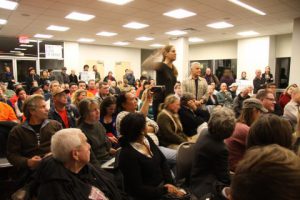“Justice for Immigrants” with Aamnah Khan (DRUM: Desis Rising Up and Moving and Arts & Democracy), Victor Monterossa, Jr. (Covenant House, New Jersey and Immigrant Workers for a Just Response), Elizabeth R. OuYang (Civi Rights Attorney, Advocate, and Eductor) and Paula Chakravartty (NYU Gallatin and NYU Sanctuary Coalition). Co-sponsored with the Departments of Labor and Urban Studies, School of Labor and Urban Studies/CUNY. Recorded on April 23, 2020.
Rebecca Amato
VIDEO: “Labor Justice” (Part 3 of Bending Toward Justice: Building Power for a Post-Pandemic Future)
“Labor Justice” with Mohamed Attia (Street Vendor Project), Ilana Berger (Hand in Hand Domestic Employers Network), and Jonathan Fostjak Bailey (Amazonians United). Co-sponsored with the Departments of Labor and Urban Studies, School of Labor and Urban Studies/CUNY. Recorded on April 16, 2020.
VIDEO: Urban Warfare: Housing Justice Under a Global Pandemic (Part 2 of Bending Toward Justice: Building Power for a Post-Pandemic Future)
“Urban Warfare: Housing Justice Under a Global Pandemic” with Raquel Rolnik (University of São Paulo, former UN Rapporteur on Adequate Housing), Daniel Aldana Cohen (University of Pennsylvania), and Cea Weaver (Upstate/Downstate Housing Alliance). Co-sponsored by NYC-DSA, Verso Books, and the Departments of Labor and Urban Studies, School of Labor and Urban Studies/CUNY. Recorded on April 14, 2020
VIDEO: “Housing Justice” (Part 1 of Bending Toward Justice: Building Power for a Post-Pandemic Future)
“Housing Justice” with Cea Weaver (Upstate/Downstate Housing Alliance), Oksana Mironova (Community Service Society), and a member of the Crown Heights Tenant Union. Co-sponsored with the Departments of Labor and Urban Studies, School of Labor and Urban Studies/CUNY. Recorded on April 7, 2020.
VIDEO: Beyond Redlining: How the Theft of Black-Owned Land and Property Endures
ANNOUNCEMENT: “Radical Cities” (NACLA Report on the Americas, Winter 2019), co-produced by Urban Democracy Lab
The Urban Democracy Lab is pleased to announce its collaboration with the North American Congress on Latin America (NACLA) to release the Winter 2019 issue of the NACLA Report on the Americas titled “Radical Cities.” This issue, co-edited by the UDL director Gianpaolo Baiocchi, focuses on municipalism, housing movements, and local radical democracy in Latin America. Below is an excerpt from the Editor’s Note, co-written by Gianpaolo and Heather Gies.
Radical Cities in Latin America: Past and Present
Even before Hugo Chávez and Luiz Inácio Lula da Silva rose to national power and kicked off discussions of a Pink Tide, scholars and activists celebrated the municipal alternative in Latin America, where Porto Alegre’s participatory budgeting and El Alto’s cooperatives set the horizon of possibility. In an interview published in the May 1989 issue of the NACLA Report, Bill Hinchberger reflected the mood of the time by asking the new mayor of São Paulo, Luiza Erundina, what she thought of the commentary that her victory “was the greatest electoral advance for the Latin American Left since Salvador Allende.”
Historic as it was, the São Paulo win was only one of 36 electoral victories that year for Brazil’s then-nascent Workers’ Party (PT). And for the next decade and a half, hundreds of leftist administrators would sweep into power in cities across the continent. These ranged from large capital cities like Caracas under the Radical Cause party, to industrial-belt cities like Rosário in Argentina under the Socialist Party, to rural municipalities like Icapuí in Brazil under the PT. When the Pink Tide governments won national power in the early 2000s, they had already rehearsed their strategies in nearly every country at the local level.
Many have remarked that those national victories brought to presidential power a remarkable cohort of activists—a diorama of the 20th century Latin American Left, in historian Greg Grandin’s words— including union leaders, radical Indigenous activists, former guerrilla fighters, and liberation theologians. Much less appreciated is how prior experiences in power at the municipal level underwrote, and indeed prefigured, much of the Pink Tide’s politics.
The story of radical cities in Latin America begins in the 1980s. As Margaret Thatcher proclaimed “there is no alternative” to free markets, socialist activists in Latin America explored ambitious experiments in collective local self-governance. In Villa El Salvador in Peru, for example, self-organized land occupation transformed the pueblo joven or shantytown on the outskirts of Lima into a legally recognized residential district by 1983. Dozens of other cities in the region soon followed with their own creative experimentation. Around the world, those looking for municipal alternatives turned to “Red Bologna” in the 1970s and United Kingdom municipal socialism in the 1980s. But for the next two decades, Latin American experiences dominated the scene.
City dwellers faced a very difficult context in those years. Under both the austerity of the 1980s and the neoliberal stability of the 1990s, urban services suffered as the population of the the region’s cities doubled. Displaced rural populations strained housing stocks and labor markets, while the wealthy barricaded themselves in gated communities and exclusive shopping malls. Yet, from Montevideo to Mexico City and from Santos, Brazil, to Ilo, Peru, nearly every country in the region developed important examples of radical local governance. Leftist administrators, usually anchored in local social movements, transformed municipal administrative machinery to carry out progressive policies while engaging local populations in novel ways that seemed to transcend traditional leftist approaches to governance and political parties. These administrations were steeped in widespread hope that held them up not only as way stations preceding the national palace, but also as bastions of anti-neoliberal resistance and staging grounds for a new kind of empowering, participatory politics.
No city played this role more prominently than Porto Alegre, the southern Brazilian city that once stood for radical possibility at the local level. Participatory budgeting was its calling card, but starting in 1989, successive PT administrations implemented progressive educational reforms, formed economic cooperatives, recognized Afro-Brazilian causes, and passed the first anti-homophobia law in the continent. These governments also achieved the seemingly impossible: marrying left-wing politics of redistribution with prize-winning good governance and electoral success. By the late 1990s, the city had become a global icon of resistance to neoliberalism. Manifesting the very spirit of alter-globalization as the host to successive World Social Forums in the early 2000s, the city welcomed a multitude of movements every year, from ATTAC to the Zapatistas, for a giant non-hierarchical discussion under the banner of Another World is Possible.
Video: Urban Intersections: Black, Queer Lives in New York City
Video: Navigating the City/State Divide: What’s Next for Progressive Elected Officials?
Video: Rebel Architecture: How to Dismantle Power Through Design
Board to Death?

Urban Democracy Lab Associate Director Rebecca Amato wrote this piece for our friends at Urban Omnibus on March 8, 2018. Many thanks to Urban Omnibus for allowing us to reprint.
What’s the relationship between liquor licenses and local democracy? The city’s 59 community boards mete out approvals, but they were intended as a framework for citizen participation in planning and land use decisions. Set in motion in the churn of urban renewal, the idea was to give citizens a say in the dramatic physical changes affecting their neighborhoods. In practice, when it comes to making decisions about the city’s future, community boards’ hands have been tied from the start. The official conduits for input in planning and land use may be strictly advisory, but that doesn’t mean they’re no place for participation. Meanwhile, from redevelopment coalitions to community benefit agreements, New Yorkers find other formulations for their desires. Below, Rebecca Amato looks at the aspirations and evolution of the city’s community boards, and at the many other ways that New Yorkers have demanded a voice and a say in the shape of their neighborhoods.
Participation will resuscitate the asthmatic democracy of American cities! The inclusion of ordinary New Yorkers in municipal decision-making will reflect the people’s will! Who could argue with such declarations? After all, what is a “government of the people, by the people, and for the people,” as Lincoln so potently put it, if not one in which the people have clear mechanisms for participation? At a time when New Yorkers are braving controversial rezonings, gentrification pressures, overloaded infrastructure, climate change threats, and rising homelessness — and as the nation endures a stunning test of democracy’s resilience — calls for local community control and lively citizen participation are increasingly alluring. This energy echoes, in many ways, the moment when community boards were established in New York City decades ago. Yet, if one were to rate community boards on their ability to represent their constituencies, influence policy, or corral democratic feeling around specific community issues, the results would be mixed. Just as they provide a platform of inclusion for “the people” — a legitimized place for that elusive participation that we so desperately believe will keep our democracy afloat — community boards also have a history of being painfully ineffective, even undemocratic, when it comes to forging monumental urban policies. And in a city driven by real estate activity, planning and development are two of the areas in which the boards’ role and validity are most vexing. [Read more here]
